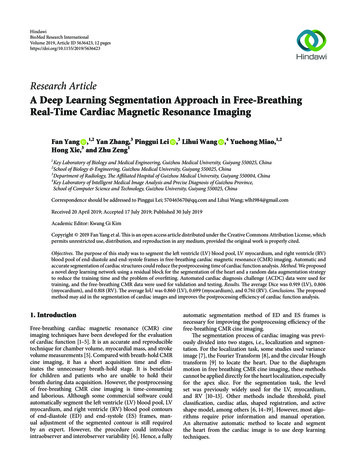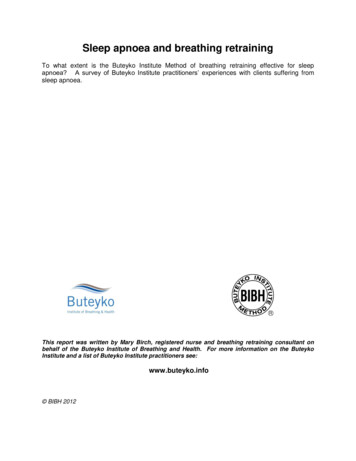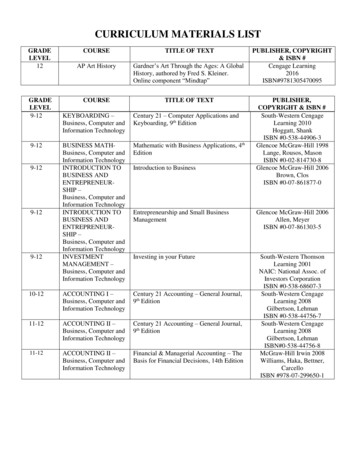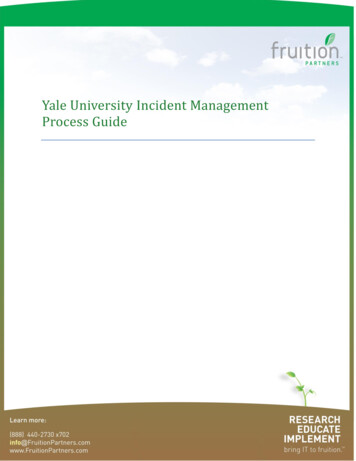
Transcription
J Bras Pneumol. -3713/e20170347REVIEW ARTICLEDysfunctional breathing: what do we know?Laís Silva Vidotto1,a, Celso Ricardo Fernandes de Carvalho2,b,Alex Harvey1,c, Mandy Jones1,d1. Department of Clinical Sciences, BrunelUniversity London, United Kingdom.2. Departamento de Fisioterapia,Faculdade de Medicina, Universidadede São Paulo (SP) 88-9060d.Submitted: 20 October 2017.Accepted: 17 February 2018.Study carried out in the Departmentof Clinical Sciences, Brunel UniversityLondon, London, England, and in theDepartamento de Fisioterapia, Faculdadede Medicina, Universidade de São Paulo,São Paulo (SP) Brasil.ABSTRACTDysfunctional breathing (DB) is a respiratory condition characterized by irregularbreathing patterns that occur either in the absence of concurrent diseases or secondaryto cardiopulmonary diseases. Although the primary symptom is often dyspnea or “airhunger”, DB is also associated with nonrespiratory symptoms such as dizziness andpalpitations. DB has been identified across all ages. Its prevalence among adults inprimary care in the United Kingdom is approximately 9.5%. In addition, among individualswith asthma, a positive diagnosis of DB is found in a third of women and a fifth of men.Although DB has been investigated for decades, it remains poorly understood becauseof a paucity of high-quality clinical trials and validated outcome measures specific tothis population. Accordingly, DB is often underdiagnosed or misdiagnosed, given thesimilarity of its associated symptoms (dyspnea, tachycardia, and dizziness) to those ofother common cardiopulmonary diseases such as COPD and asthma. The high ratesof misdiagnosis of DB suggest that health care professionals do not fully understandthis condition and may therefore fail to provide patients with an appropriate treatment.Given the multifarious, psychophysiological nature of DB, a holistic, multidimensionalassessment would seem the most appropriate way to enhance understanding anddiagnostic accuracy. The present narrative review was developed as a means ofsummarizing the available evidence about DB, as well as improving understanding of thecondition by researchers and practitioners.Keywords: Hyperventilation; Pulmonary ventilation; Respiratory system; Pulmonarymedicine.INTRODUCTIONDysfunctional breathing (DB) is a respiratory conditionthat is often poorly understood among health careprofessionals worldwide, leading to its underdiagnosisand misdiagnosis in clinical practice.(1,2) The reasons forits misdiagnosis include a lack of studies investigatingits pathophysiology, classification, and symptoms, aswell as the similarity between the symptoms of DBand those of common cardiopulmonary diseases, suchsymptoms including dyspnea, tachycardia, dizziness,and paresthesia.(3) Misunderstandings about the causes,diagnosis, and treatment of DB appear to indicate thathealth care professionals do not fully understand thiscondition and may therefore fail to provide patients withan appropriate treatment, which could lead to impairedhealth-related quality of life (HRQoL).(4) What is knownto date is that DB involves different forms of abnormalbreathing patterns,(5) and that it affects approximately9.5% of all adults in primary care in the United Kingdom.(5)DB has been shown to occur in individuals from 17 to88 years of age,(2,6,7) being most common in women andin individuals with asthma.(5,8) However, the prevalenceof DB can be overestimated or underestimated, giventhe fact that there is currently no gold-standard tool fordiagnosing the condition. Therefore, in this narrativereview, we will discuss the definition of DB, as well asthe evidence base for its physiological, functional, andpsychological characteristics. Our intention is to improveunderstanding of DB, based on the available scientificevidence, on the part of health care professionals.DEFINITION AND CLASSIFICATION OF DBDB is generally characterized by abnormal breathingpatterns(4,9) that occur either in the absence of organicdiseases (i.e., due to psychogenic causes such asanxiety)(10,11) or secondary to cardiopulmonary/neurologicaldiseases (i.e., due to organic/physiological causes suchas asthma and heart failure).(5,12) Jones et al.(6) dubbedthe former classification “primary DB” and the latter“secondary DB”.(6) It is noteworthy that DB is secondaryto organic causes when the physiological alterationsare insufficient to explain the evident symptoms (e.g.,dyspnea) or the blood gas analysis results.(13) Figure 1shows a representation of “abnormal breathing patterns”.It is important to emphasize that those abnormal patternscan appear with greater recruitment of the accessorymuscles of respiration or in cases of chronic respiratoryalkalosis.(4,14,15)In recent years, researchers have proposed somealternative classifications for different patterns of DB.Barker and Everard(4) reviewed the literature andsuggested a new definition of DB: “an alteration in theCorrespondence to:Laís S. Vidotto. Department of Clinical Sciences, Brunel University London, Kingston Lane, Uxbridge, Middlesex, UB8 3PH, London, UK.Tel: 44 0 1895-268-985. Email: lais.vidotto@brunel.ac.ukFinancial support: This study was financed in part by the Coordenação de Aperfeiçoamento de Pessoal de Nível Superior-Brasil (CAPES) - Finance Code 001. 2019 Sociedade Brasileira de Pneumologia e TisiologiaISSN 1806-37131/9
Dysfunctional breathing: what do we know?normal biomechanical patterns of breathing thatresult in intermittent or chronic symptoms whichmay be respiratory and/or non-respiratory”. Amongthe respiratory symptoms listed by the authors weredyspnea and hyperventilation, whereas their list ofnonrespiratory symptoms included dizziness andtachycardia. The authors also highlighted the fact thatpattern disordered breathing is the main component ofany form of DB. Table 1 shows the classifications of DBproposed by various authors. The evident differencesacross studies regarding the classification of DB and theterminology employed in describing it underscore theneed to move from an incipient stage (of discovery) toa more developed phase (of diagnosis and treatment).The most well-known form of DB is hyperventilationsyndrome (HVS), which is defined as acute or chronichyperventilation (increased minute volume) at restor during exercise/stress.(16,17) As a form of DB, HVSmay be due to organic/physiological conditions butis mainly caused by psychological/behavioral factors(e.g., anxiety, depression, perfectionism, and feelingsof inferiority).(16,18) For many years, it was thought thatHVS was always accompanied by hypocapnia, whichcan trigger nonrespiratory symptoms such as dizziness,palpitations, numbness, and a tingling sensation.(19)However, recent studies indicate that such symptomscould be triggered by other, as yet unknown, factors,given that respiratory alkalosis is not always presentin HVS.(4,13,20)There is another form of DB, known as idiopathichyperventilation (IH), in which patients have chronicasymptomatic hyperventilation and respiratory alkalosis,that cannot be attributed to an underlying disease.(18)Jack et al.(21) showed that IH is mainly caused bypsychological factors, becoming a conditioned response.In a subsequent study, Jack et al.(18) hypothesized thatIH is caused by increased respiratory responsivenessto carbon dioxide levels, to hypoxia, or to an increasedeep sighnormal breathingnormal breathingTidal volumebreath holdinghyperventilationFigure 1. Representative figure showing the “normal” breathing patterns and the “abnormal” breathing patternspresented by individuals with dysfunctional breathing. Normal breathing is the standard tidal volume and respiratoryrate of an individual; breath holding is when a breath is held for a period of time; a deep sigh is a deep inspiration thathappens at any time during breathing; and hyperventilation is an increase in the respiratory rate, tidal volume, or both.Note: The order in which abnormal breathing patterns appear may vary.Table 1. Recent classifications of dysfunctional breathing suggested by different authors.AuthorsClassificationBoulding et al.(9)Hyperventilation syndromePeriodic deep sighingThoracic dominant breathingForced abdominal expirationThoracoabdominal asynchronyBarker and Everard(4)Thoracic DBExtrathoracic DBFunctional DB (a subdivision of thoracic andextrathoracic DB)Structural DB (a subdivision of thoracic andextrathoracic DB)DB: dysfunctional breathing.2/9J Bras Pneumol. 2019;45(1):e20170347DefinitionRelated to respiratory alkalosis or independent of hypocapniaUsually associated with an irregular breathing patternCan manifest more often in somatic diseasesEvident when there is inappropriate and excessive abdominalmuscle contraction during expirationCharacterized by a delay between intercostal and abdominalcontraction, causing ineffective respiratory mechanicsSignificant changes in the breathing pattern that may or maynot be directly linked to hyperventilationUpper airway impairment manifested in combination withbreathing pattern disorders (e.g., vocal cord dysfunction)No structural or functional alterations directly associated withthe symptoms of DB (e.g., phrenic nerve palsy, myopathy, anddiaphragmatic eventration)Primarily associated with anatomical or neurological alterations(e.g., subglottic stenosis and unilateral cord palsy)
Vidotto LS, Carvalho CRF, Harvey A, Jones Min the metabolic rate, although that hypothesis hasnot been tested.DIAGNOSIS OF DBNijmegen QuestionnaireCurrently, the Nijmegen Questionnaire (NQ) is themost widely used instrument for identifying individualswith DB.(22,23) The NQ was developed by van Dixhoornand Duivenvoorden in 1985.(23) Although the authorsdid not specify whether the participants had primaryor secondary HVS, they mentioned the exclusion ofparticipants with somatic disorders, which would suggestthe exclusion of those with primary DB. Nevertheless,they included no information on whether any of theparticipants had a history of asthma or other healthconditions.The NQ consists of 16 questions related to complaints,and the frequency of symptoms can be indicated ona scale ranging from 1 (never) to 5 (very often). Ithas a sensitivity and specificity of 91% and 95%,respectively, in relation to the clinical diagnosis of HVS.The questions are primarily related to physiologicalfactors (e.g., cardiovascular and respiratory symptoms)and psychological factors (e.g., tension). However, itis noteworthy that this instrument was developed asa symptom-based questionnaire to screen for HVS.(23)In fact, the NQ has been validated only for use inpatients with HVS secondary to asthma (i.e., not foruse in those with other forms of DB).(24) In addition,the NQ has yet to be translated to Portuguese orvalidated for use in Brazil. In a recent article, one ofthe creators of the NQ stated that it has been usedincorrectly worldwide,(25) stating that it should be usedonly to identify abnormal symptoms related to HVSand not as the gold-standard test to diagnose DBper se, because it was not created for that purpose.However, given that HVS was the first form of DB tobe investigated and is still the most well understoodform of the condition, several tools, other than the NQ,have been developed to facilitate the identification ofhyperventilation (as described below).The hyperventilation provocation test toidentify HVSThe hyperventilation provocation test (HVPT) wasonce considered to be the cornerstone of the diagnosisof HVS.(26) The HVPT requires patients to breathe asdeeply and quickly as possible for a certain lengthof time (typically 2 or 3 min). To determine whetherpatients have HVS, the authors who developed theHVPT suggested that clinicians check patient reports ofsymptoms and experiences during the test. If a patientreports symptoms and sensations that are similar tothose experienced regularly in their daily lives, thepresence of HVS can be confirmed.(27) However, anumber of researchers have begun to question whetherthe HVPT is a valid tool to detect HVS, because itdoes not differentiate between symptoms caused byhypocapnia and those caused by task-related anxietyor mechanical discomfort.(28) In such instances, theHVPT is highly likely to overestimate the prevalenceof HVS.(13,28) In addition, a delay for blood CO2 levelsto return to baseline values after an HVPT was oncebelieved to be diagnostic of HVS.(27) However, it waslater shown that the length of the delay in CO2 recoverydoes not differ between patients with HVS and healthyindividuals.(28)Cardiopulmonary exercise testing toidentify HVSAnother means of facilitating the diagnosis ofHVS is cardiopulmonary exercise testing.(18,20) Suchtesting has been recommended when patients do notexperience HVS-related symptoms at rest but healthcare professionals suspect that, based on patientreports, these sensations are likely to occur duringmovement. (18,20) That assumption is predicated oncompelling evidence indicating that, on incrementalcycle ergometer tests, individuals with chronic IHshow lower end-tidal CO2 tension, higher minutevolume, slower recovery, and a higher degree ofdyspnea (disproportionate to the increase in minutevolume), as well as supporting lower workloads, thando healthy individuals.(18,20,21) Although the use ofcardiopulmonary exercise testing might also facilitatethe exclusion of other causes of dyspnea,(29) the protocolfor the identification of HVS during cardiopulmonaryexercise testing has yet to be standardized. Therefore,exercise tests appear to be complementary tools thatcan facilitate the detection of HVS in more complexsituations, in which patients do not show any of theaforementioned symptoms at rest.PHYSIOLOGICAL CHARACTERISTICS OF DBPulmonary functionAlthough pulmonary function test parameters, suchas FEV1 and FVC, are widely used to classify res
Dysfunctional breathing (DB) is a respiratory condition characterized by irregular breathing patterns that occur either in the absence of concurrent diseases or secondary to cardiopulmonary diseases. Although the primary symptom is often dyspnea or “air hunger”, DB is also associated with nonrespiratory symptoms such as dizziness and











